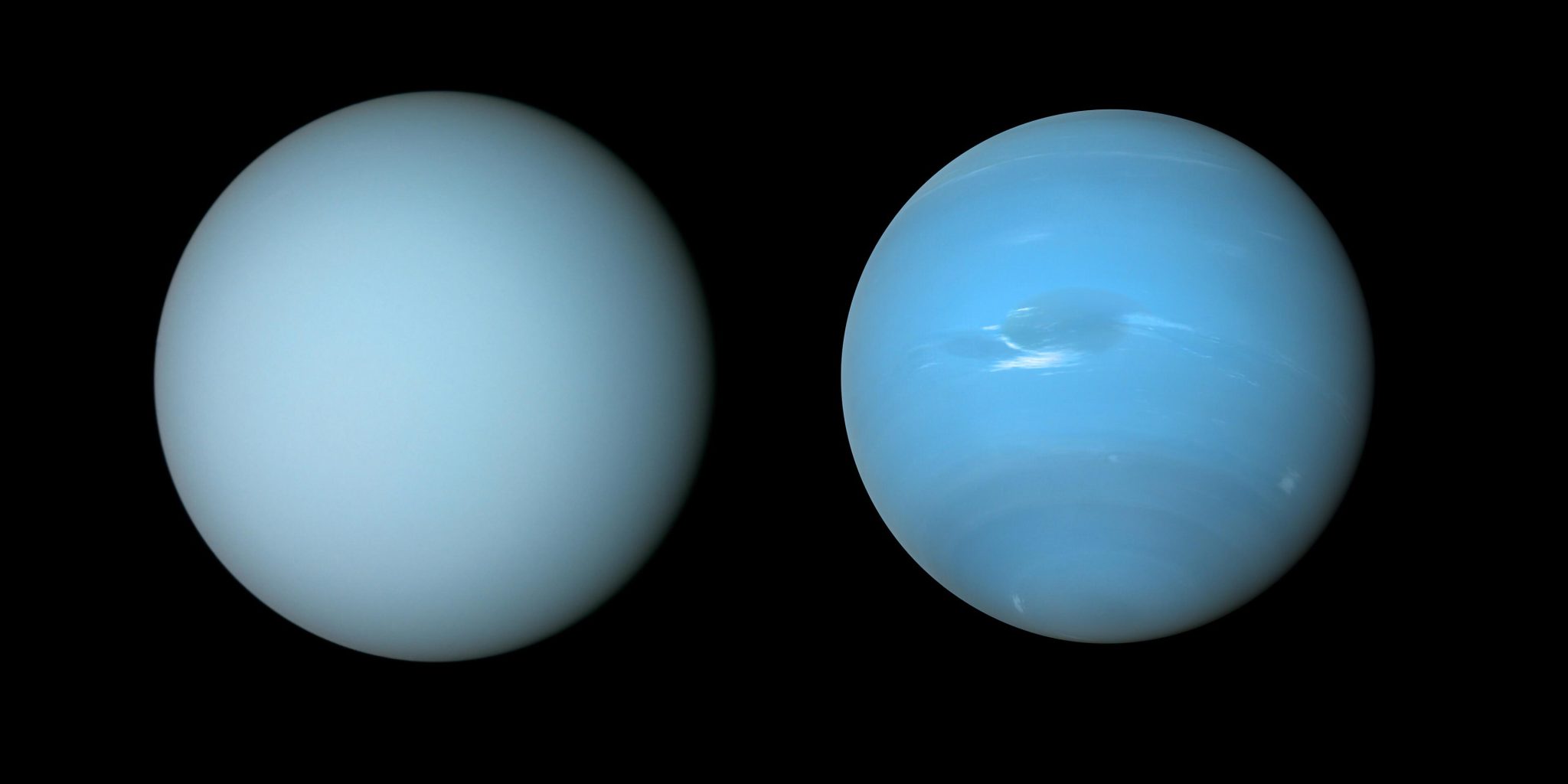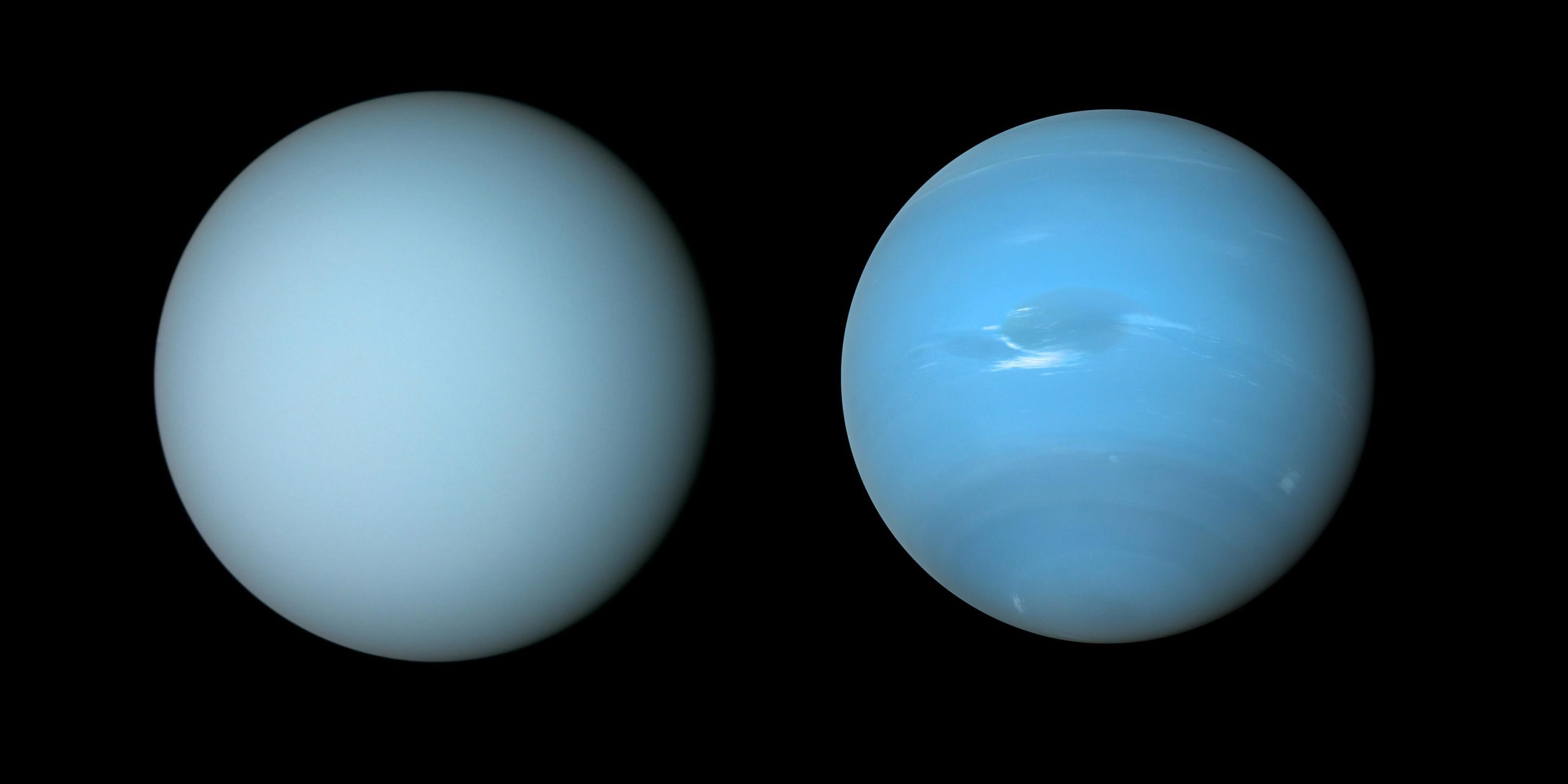
A espaçonave Voyager 2 da NASA capturou essas imagens de Urano (esquerda) e Netuno (direita) durante sobrevoos planetários na década de 1980. Crédito: NASA/JPL-Caltech/B. Johnson
Observações do Observatório Gemini e outros telescópios revelam neblina excessiva[{” attribute=””>Uranus makes it paler than Neptune.
Astronomers may now understand why the similar planets Uranus and Neptune have distinctive hues. Researchers constructed a single atmospheric model that matches observations of both planets using observations from the Gemini North telescope, the NASA Infrared Telescope Facility, and the Hubble Space Telescope. The model reveals that excess haze on Uranus accumulates in the planet’s stagnant, sluggish atmosphere, giving it a lighter hue than Neptune.
Os planetas Netuno e Urano compartilham muito em comum – eles têm massas, tamanhos e composições atmosféricas semelhantes – mas suas aparências são marcadamente diferentes. Em comprimentos de onda visíveis, Netuno é visivelmente mais azul, enquanto Urano é um tom mais pálido de ciano. Os astrônomos agora têm uma explicação de por que os dois planetas são tão diferentes em cores.
Novas pesquisas indicam que a camada de neblina concentrada encontrada em ambos os planetas é mais espessa em Urano do que uma camada semelhante em Netuno e “embranquece” a aparência de Urano mais do que em Netuno.[1] Se não houver neblina ambiente De Netuno e Urano, ambos aparecerão aproximadamente iguais em azul.[2]
Esta conclusão vem de um modelo[3] que uma equipe internacional liderada por Patrick Irwin, professor de física planetária da Universidade de Oxford, desenvolveu para descrever as camadas de aerossol nas atmosferas de Netuno e Urano.[4] Investigações anteriores das atmosferas superiores desses planetas se concentraram na aparência da atmosfera apenas em comprimentos de onda específicos. No entanto, este novo modelo, composto por múltiplas camadas atmosféricas, corresponde a observações de ambos os planetas em uma ampla gama de comprimentos de onda. O novo modelo também inclui partículas difusas dentro de camadas mais profundas que anteriormente se pensava conter apenas nuvens de metano e gelo de sulfeto de hidrogênio.

Este diagrama mostra três camadas de aerossóis nas atmosferas de Urano e Netuno, projetadas por uma equipe de cientistas liderada por Patrick Irwin. O altímetro no gráfico representa a pressão acima de 10 bar.
A camada mais profunda (camada de aerossol-1) é espessa e consiste em uma mistura de gelo de sulfeto de hidrogênio e partículas provenientes da interação de atmosferas planetárias com a luz solar.
A camada principal que afeta as cores é a camada intermediária, que é uma camada de partículas de névoa (referida no artigo como camada de aerossol-2) que é mais espessa em Urano do que em Netuno. A equipe suspeita que em ambos os planetas, o gelo de metano se condensa nas partículas dessa camada, puxando as partículas mais para dentro da atmosfera à medida que as neves de metano caem. Como a atmosfera de Netuno é mais ativa e turbulenta que a de Urano, a equipe acredita que a atmosfera de Netuno é mais eficiente em desviar partículas de metano para a camada de neblina e produzir essa neve. Isso remove mais neblina e mantém a camada de neblina de Netuno mais fina do que em Urano, o que significa que o azul de Netuno parece ser mais forte.
Acima de ambas as camadas há uma camada estendida de neblina (camada de aerossol 3) semelhante à camada abaixo, mas mais frágil. Em Netuno, grandes partículas de gelo de metano também se formam acima dessa camada.
Crédito: Observatório Internacional Gemini/NOIRLab/NSF/AURA, J. da Silva/NASA/JPL-Caltech/B. Johnson
“Este é o primeiro modelo que se ajusta sincronicamente às observações da luz solar refletida do ultravioleta ao infravermelho próximo”, explicou Irwin, principal autor de um artigo de pesquisa que apresenta essa descoberta no Journal of Geophysical Research: Planets. “Ele também é o primeiro a explicar a diferença de cor visível entre Urano e Netuno.”
O modelo da equipe consiste em três camadas de aerossóis em diferentes altitudes.[5] A camada principal que afeta as cores é a camada intermediária, que é uma camada de partículas de névoa (referida no artigo como camada de aerossol-2) que é mais espessa sobre o Urano Do Netuno. A equipe suspeita que em ambos os planetas, o gelo de metano se condensa nas partículas dessa camada, puxando as partículas mais para dentro da atmosfera à medida que as neves de metano caem. Como a atmosfera de Netuno é mais ativa e turbulenta que a de Urano, a equipe acredita que a atmosfera de Netuno é mais eficiente em desviar partículas de metano para a camada de neblina e produzir essa neve. Isso remove mais neblina e mantém a camada de neblina de Netuno mais fina do que em Urano, o que significa que o azul de Netuno parece ser mais forte.
Mike Wong, astrônomo da[{” attribute=””>University of California, Berkeley, and a member of the team behind this result. “Explaining the difference in color between Uranus and Neptune was an unexpected bonus!”
To create this model, Irwin’s team analyzed a set of observations of the planets encompassing ultraviolet, visible, and near-infrared wavelengths (from 0.3 to 2.5 micrometers) taken with the Near-Infrared Integral Field Spectrometer (NIFS) on the Gemini North telescope near the summit of Maunakea in Hawai‘i — which is part of the international Gemini Observatory, a Program of NSF’s NOIRLab — as well as archival data from the NASA Infrared Telescope Facility, also located in Hawai‘i, and the NASA/ESA Hubble Space Telescope.
The NIFS instrument on Gemini North was particularly important to this result as it is able to provide spectra — measurements of how bright an object is at different wavelengths — for every point in its field of view. This provided the team with detailed measurements of how reflective both planets’ atmospheres are across both the full disk of the planet and across a range of near-infrared wavelengths.
“The Gemini observatories continue to deliver new insights into the nature of our planetary neighbors,” said Martin Still, Gemini Program Officer at the National Science Foundation. “In this experiment, Gemini North provided a component within a suite of ground- and space-based facilities critical to the detection and characterization of atmospheric hazes.”
The model also helps explain the dark spots that are occasionally visible on Neptune and less commonly detected on Uranus. While astronomers were already aware of the presence of dark spots in the atmospheres of both planets, they didn’t know which aerosol layer was causing these dark spots or why the aerosols at those layers were less reflective. The team’s research sheds light on these questions by showing that a darkening of the deepest layer of their model would produce dark spots similar to those seen on Neptune and perhaps Uranus.
Notes
- This whitening effect is similar to how clouds in exoplanet atmospheres dull or ‘flatten’ features in the spectra of exoplanets.
- The red colors of the sunlight scattered from the haze and air molecules are more absorbed by methane molecules in the atmosphere of the planets. This process — referred to as Rayleigh scattering — is what makes skies blue here on Earth (though in Earth’s atmosphere sunlight is mostly scattered by nitrogen molecules rather than hydrogen molecules). Rayleigh scattering occurs predominantly at shorter, bluer wavelengths.
- An aerosol is a suspension of fine droplets or particles in a gas. Common examples on Earth include mist, soot, smoke, and fog. On Neptune and Uranus, particles produced by sunlight interacting with elements in the atmosphere (photochemical reactions) are responsible for aerosol hazes in these planets’ atmospheres.
- A scientific model is a computational tool used by scientists to test predictions about a phenomena that would be impossible to do in the real world.
- The deepest layer (referred to in the paper as the Aerosol-1 layer) is thick and is composed of a mixture of hydrogen sulfide ice and particles produced by the interaction of the planets’ atmospheres with sunlight. The top layer is an extended layer of haze (the Aerosol-3 layer) similar to the middle layer but more tenuous. On Neptune, large methane ice particles also form above this layer.
More information
This research was presented in the paper “Hazy blue worlds: A holistic aerosol model for Uranus and Neptune, including Dark Spots” to appear in the Journal of Geophysical Research: Planets.
The team is composed of P.G.J. Irwin (Department of Physics, University of Oxford, UK), N.A. Teanby (School of Earth Sciences, University of Bristol, UK), L.N. Fletcher (School of Physics & Astronomy, University of Leicester, UK), D. Toledo (Instituto Nacional de Tecnica Aeroespacial, Spain), G.S. Orton (Jet Propulsion Laboratory, California Institute of Technology, USA), M.H. Wong (Center for Integrative Planetary Science, University of California, Berkeley, USA), M.T. Roman (School of Physics & Astronomy, University of Leicester, UK), S. Perez-Hoyos (University of the Basque Country, Spain), A. James (Department of Physics, University of Oxford, UK), J. Dobinson (Department of Physics, University of Oxford, UK).
NSF’s NOIRLab (National Optical-Infrared Astronomy Research Laboratory), the US center for ground-based optical-infrared astronomy, operates the international Gemini Observatory (a facility of NSF, NRC–Canada, ANID–Chile, MCTIC–Brazil, MINCyT–Argentina, and KASI–Republic of Korea), Kitt Peak National Observatory (KPNO), Cerro Tololo Inter-American Observatory (CTIO), the Community Science and Data Center (CSDC), and Vera C. Rubin Observatory (operated in cooperation with the Department of Energy’s SLAC National Accelerator Laboratory). It is managed by the Association of Universities for Research in Astronomy (AURA) under a cooperative agreement with NSF and is headquartered in Tucson, Arizona. The astronomical community is honored to have the opportunity to conduct astronomical research on Iolkam Du’ag (Kitt Peak) in Arizona, on Maunakea in Hawai‘i, and on Cerro Tololo and Cerro Pachón in Chile. We recognize and acknowledge the very significant cultural role and reverence that these sites have for the Tohono O’odham Nation, the Native Hawaiian community, and the local communities in Chile, respectively.

“Criador. Viciado em mídia social que gosta de hipster. Fã da web. Fanático por álcool apaixonado.”











More Stories
A Boeing pode não conseguir operar o veículo Starliner antes que a estação espacial seja destruída
Vivendo com ansiedade: conselhos de especialistas sobre como aceitar um problema de saúde mental
Nova pesquisa sobre uma enorme falha de impulso sugere que o próximo grande terremoto pode ser iminente